With over a year in the making, this series of posts is finally entering the home stretch, with the last four values of the set: the 20c, 25c, 50c and $1. This week I will deal with all the printings of the 20c value, which depicts "The Ferry Quebec" by J.W. Morrice. It is one of the less complicated values in the set, at least according to Unitrade. However, as we shall see, there is still plenty of scope to interest the specialist. Interestingly, none of the high values from this point forward exist with general Ottawa tagging. This value exists only Winnipeg tagged.
According to Unitrade, the printings with dextrine gum were in use from February 8, 1967, when the set was first issued, until May 1972, when the printings with PVA gum replaced them. The life of these later printings was very brief, as the 20c Prairies from the Caricature Issue was issued on September 8, 1972. The Winnipeg tagged stamps appeared on December 9, 1969, on cream paper with dextrine gum, and these were replaced by printings on whiter paper, with PVA gum in May 1972 as well.
The remainder of this post will explore the attributes of all the printings of these stamps.
Paper Attributes Other Than Fluorescence
Apart from the fluorescence level of the paper, there are other attributes of the paper that differ between printings. The following paper types have been found in studying these stamps:
- A cream coloured horizontal wove paper, that shows clear vertical mesh when viewed from the back, and when held up to back lighting. The printing surface has a very light surface coating which prevents loose fibres from appearing on the surface. This paper is generally only found with dextrine gum. Quite often the vertical mesh will actually be visible on the gum as light ribbing. When viewed against strong back lighting, in addition to the vertical mesh, a clear horizontal mesh is also visible, so the paper appears to be woven in both directions.
- A whiter vertical wove paper that also shows very clear vertical mesh when viewed from the back and when held up to back lighting. The printing surface also has a very light surface coating on it as well. This is the paper typically associated with the hibrite level of fluorescence.
- A whiter horizontal wove paper that shows no mesh pattern at all when viewed from the back, but shows a faint horizontal mesh pattern visible. or when held up to the light. When you look at the printing surface under magnification, you can see a light surface coating, and you can also see that the paper has a slightly bumpy surface. This paper is only found with PVA gum.
- A cream coloured paper that is identical to (1) above, but instead of being horizontal wove, is vertical wove instead.
- A cream coloured, horizontal wove paper that is the same in all respects as (1) above, except that the vertical mesh is not visible unless held up and viewed against a strong back-light.
- A deep cream coloured vertical wove paper, that has a light surface coating. There is no mesh pattern visible at all, either when viewed from the back, or when the stamp is held up and viewed against back lighting.
- A cream coloured vertical wove paper that has a light surface coating. There is no mesh pattern visible at all, either when viewed from the back, or when the stamp is held up and viewed against back lighting.
The scan below shows an example of both the cream paper and the whiter paper against a stark white background. The difference is subtle, but definitely visible:
The cream paper is shown on the left, while the whiter paper is on the right. As you can see, the cream paper has a somewhat yellowish appearance compared to the whiter paper. The whiter paper is found with dextrine gum on those printings with hibrite fluorescence, and on the PVA gum printings. The cream paper is confined to the printings made before August 1971.
The next picture shows the gum side of two stamps on each of the first two paper types. In the picture you can clearly see the vertical ribbing in the gum:
So, to recap, paper types 1, and 4-7 are found with various levels of dull fluorescence. Type 2 is found only in either the hibrite or high fluorescent levels of fluorescence, and type 3 is only found with PVA gum.
Paper Fluorescence
Unitrade lists four levels of fluorescence for these stamps, three of which are shown above:
- Non-fluorescent (not shown).
- Dull fluorescent (top right).
- Hibrite (top left).
- Low fluorescent (bottom).
Again, as is often the case with Unitrade's listings, the paper described as low fluorescent is actually a highly flecked dull fluorescent paper that contains so much fluorescent fibres that it appears low fluorescent. As is the case with all the stamps of this series, the basic levels of fluorescence do show variations, and I will now illustrate and discuss those in more detail.
Dull Fluorescent Papers
This first scan shows the first group of dull fluorescent papers. They all appear grey under UV light, that contains a slight yellowish tinge. So I call this the ivory grey. The stamp sitting on top of the blocks contains no fluorescent fibres, while both blocks contain different concentrations of fluorescent fibres. The block on the left contains almost none: just 1-2 low fluorescent and maybe another 1-2 high fluorescent fibres on each stamp. The block on the right contains very few medium and high fluorescent fibres.
This scan shows the next two types of dull fluorescent paper. This time the paper appears more of a definite grey under the UV light, in that it does not have the yellowish tinge, and there is more fluorescent fibre content in the paper. The block on the right contains very few low, medium high fluorescent and hibrite fibres. The block on the left is similar, except that there are many fewer hibrite fibres present in the paper - perhaps only 1-2 per stamp.
The next two types of dull fluorescent paper are shown in the next scan. The grey paper with minimal fluorescent fibres is shown at the upper left. The stamp at the upper right is whiter and bluish, so I call it the bluish white paper. It contains a very sparse concentration of both medium and high fluorescent fibres. The stamp on the bottom is the greyish white paper and contains very few medium and high fluorescent fibres.
The next type of dull fluorescent paper is shown by the stamp on the left in the above scan. The tagged stamp on the right is the dull fluorescent ivory grey paper, with minimal fluorescent fibres. The stamp on the left is the dull fluorescent greyish paper that contains a sparse concentration of medium fluorescent fibres and a very sparse concentration of high fluorescent fibres, that give it the appearance of being dull fluorescent bluish white.
Here is an example of the dull fluorescent deep grey paper that contains almost no fluorescent fibres in the paper - just a few medium and high fluorescent fibres. It is also a good example of the vertical wove paper, as can be seen from the way in which the block is curling (from side to side).
Here is the dull fluorescent ivory paper. It looks quite a bit more yellowish than this in actuality. This paper contains no fluorescent fibres.
This is the dull fluorescent light ivory paper containing very few medium and high fluorescent fibres. Again, it is slightly more yellowish than the camera makes it appear here. However, it is not as yellowish as the regular ivory paper.
So, in all, I have identified 11 different types of the dull fluorescent paper. Admittedly, many of these varieties are extremely subtle, and many collectors may consider their inclusion to be too specialized for their tastes. However, I include them all here.
The Non-Fluorescent Papers
I have so far only found two examples of the non-fluorescent paper in my stock. Both are shown above, next to a dull fluorescent light ivory stamp, which is shown at the top right of the scan. As you can see the difference is quite outstanding. Both papers appear deep grey under the UV light, with one being slightly deeper than the other. Both show no fluorescent fibres whatsoever.
Hibrite Papers
As is often the case with the so called hibrite paper on this issue, this stamp shows variations in the brightness of the paper, such that there is a true hibrite level of fluorescence, as well as a slightly duller high fluorescent level. The picture below shows the difference between these two levels of fluorescence:
The true hibrite is shown at the left, while the stamp on the right is more of a high fluorescent level of fluorescence, rather than a true hibrite.
Low Fluorescent Papers
I have only found two very close varieties of the low fluorescent paper, and both are shown above. The stamp on the left appears a pale blue grey, while the one on the right appears a deeper blue grey under the UV light. The paper of the left stamp contains sparse concentrations of low and medium fluorescent fibres, and very few brownish woodpulp fibres. The stamp on the right contains a low density concentration of low fluorescent fibres, a sparse concentration of medium fluorescent fibres and very few high fluorescent fibres and brownish woodpulp fibres. I have shown them both from the back, rather than the front, as it is easier to see the characteristics this way.
Shades
There are several different shades of the blue ink to be found on this stamp. Generally the original printings are in a much deeper shade of blue, which becomes brighter as time progresses. The shades that I have found on these stamps are shown in the scans below.
The first two are dextrine gum printings on dull fluorescent and hibrite paper:
The blue on the left is much brighter than the one on the right, which is quite blackish by comparison. The left stamp on the Gibbons colour key is close to the deep blue swatch, but is brighter. So, I would classify it as the deep bright blue, which is not shown specifically on the key. The stamp on the left is a perfect match to Gibbons' indigo.
The deep bright blue is found on the dextrine gum printings well as the PVA gum printings.
There is a paler version of the deep bright blue, which for lack of a better term, I would simply call the bright blue. It has been found on some of the dextrose gum printings, including those with Winnipeg tagging. It is shown in the scan below:
Here I have superimposed the deep bright blue stamp on top of a tagged corner block in the brighter blue shade. You can see the difference clearly if you compare the stamps with a relaxed gaze and do not focus too intently on the images.
Under UV light, the inks appear close to black, but are still identifiable as shades of dark blue, for all printings except the high fluorescent/hibrite papers, which appear black. Therefore the inks used for all printings except the high fluorescent and hibrite can be classified as non-transformative, while the other inks are all transformative.
Gum
In carefully studying these stamps, I have found seven types of the dextrine gum and only one type of the PVA gum. All are illustrated below:
The first two types of dextrine gum are shown above, and are a light cream colour with a semi-gloss sheen. The top type is the streaky version, which exhibits a regular horizontal pattern of small blemishes in the gum surface, while the bottom type is the smooth version, which is uniform and shows no blemishes at all.
The next type is also a light cream, smooth gum that has a glossy sheen:
This picture is not 100% in focus, because the camera just would not focus for some reason. However, I believe that I have been able to capture the glossy sheen, from the light reflected off the surface.
The next two types of gum are a deeper cream colour and are both smooth. The top stamp has gum that exhibits a semi-gloss sheen, while the bottom stamp's gum is slightly duller, exhibiting a satin sheen.
The next types are both highly streaky and have a semi-gloss sheen:
Both types of gum exhibit a regular horizontal pattern of blemishes. The gum on the block is a deep cream colour, while the stamp's gum is a deeper yellowish cream. The difference in colour is apparent from a simple comparison of the two.
The last type of gum is the standard white PVA that we have seen on all the other values:
This is the PVA gum that is thicker and has the satin sheen. I have not yet found an example with the duller eggshell sheen.
Perforations
I have found all four line perforations on all printings of these stamps, including the printings with PVA gum. So, the possible perforations are: 11.85, 11.95, 11.95 x 11.85 and 11.85 x 11.95.
Winnipeg Tagging
The configuration of the Winnipeg tagging on this value is the same as on all the other high values. The width of the bands is 8.5 mm and they were applied down the vertical perforations, with 1 mm narrower horizontal spacing between bands on the outer columns of the sheets compared to the inner columns. They were also applied in two operations, with the first set of bands applied to the top three panes in the print layout, and then to the bottom three. Thus, corner blocks from the bottom positions in the upper panes and the upper positions of the lower panes will all show gaps in the tagging, where the first tagging application ends and the second begins. Lower positions from the lower panes can thus always be identified by the fact that the tagging bars terminate well short of the bottom of the selvage, with no evidence of a second band.
In terms of visibility, on the the dextrine gum printings I find the bands are a very pale yellow in normal light, and are not difficult to see, but at the same time are not obvious. Under UV light, they appear a light bluish white, as shown in the picture below:
On the PVA gum printings, the intensity of application does vary, so that on some stamps the bands appear a deeper yellow in normal light than on others. Under UV light, the bands appear more yellowish than bluish.
The picture below shows the variations in intensity of tagging bars that can be found under UV light:
The right stamp has pale yellowish cream bars in normal light, that are quite difficult to see, and under UV, they are not that much more visible, being a very pale bluish white discolouration at the sides of the stamp. The left stamp has much deeper yellowish bars that are obvious in normal light, and under UV, they appear quite yellowish as well. You can see the yellow if you look at the lower right corner of the left stamp.
According to Rose, both the dextrine gum and PVA gum printings exist with G2Ac tagging errors, in which a single wide tagging bar appears at the centre. These are very scarce and highly sought after.
Plate Flaws
I have not discovered any plate flaws of note on this denomination, nor have I come across any plastic flow varieties.
Putting it All Together
The dextrine gum stamps were printed from two plates. For these, I have identified:
- 6 types of paper.
- 15 levels of fluorescence.
- 3 shades.
- 7 gum types
- 4 different perforations
- 4 different types of tagging - light and dark, narrow and wide spacing.
So, for the stamps with dextrine gum, the number of collectible single stamps can be as high as:
(5 x 11 x 3 x 7 x 4 x 4)+(2 x 1 x 3 x 7 x 4) + (2 x 1 x 3 x 7 x 4) = 18,480 + 168 + 168 = 18,816 stamps!
For each untagged stamp, there can be 8 different plate blocks, and up to 12 different blank corner blocks, so the number of possible plate blocks are:
(4,620 x 8) + (168 x 8) = 38,304 plate blocks!
The number of potentially collectible corner blocks is:
18,816 x 12 = 225,792 blocks!
This is crazy, and obviously it is unlikely that every permutation and combination of paper, fluorescence, shade and gum variety exists. But it would be a lot of fun to devote your collecting to trying to find out just how many different varieties you can find.
For the PVA gum stamps, I have found:
- 2 levels of fluorescence
- 1 type of paper and gum
- 1 shade
- 4 perforations
- 1 plate - all stamps came from plate 2.
- 4 types of tagging - light and dark, narrow and wide spacing.
So, the number of collectible stamps, blocks and corner blocks is much more manageable:
2 x 1 x 1 x 4 x 4 = 32 stamps, 32 plate blocks and 384 corner blocks.
This brings us to the end of the 20c value of the series. Next week I will explore the printings of the 25c Solemn Land stamp.
Want to receive more posts like this automatically? Subscribe to the feed for this blog at:
http://brixton-chrome.myshopify.com/blogs/canadianstampsandpostalhistory.atom.


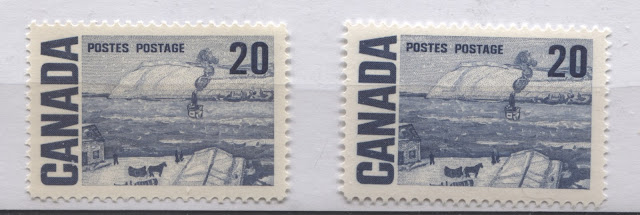
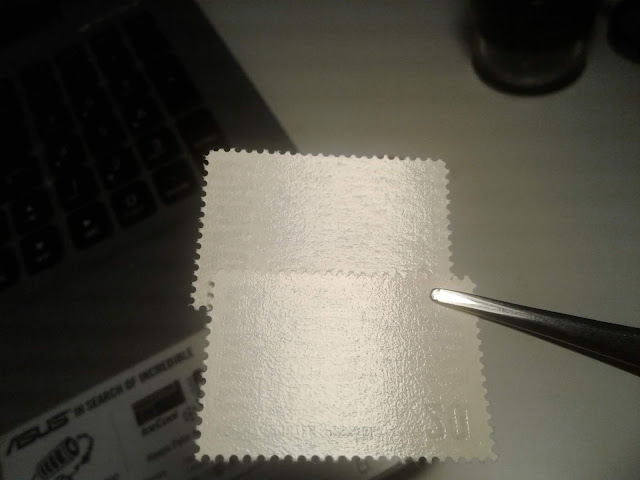
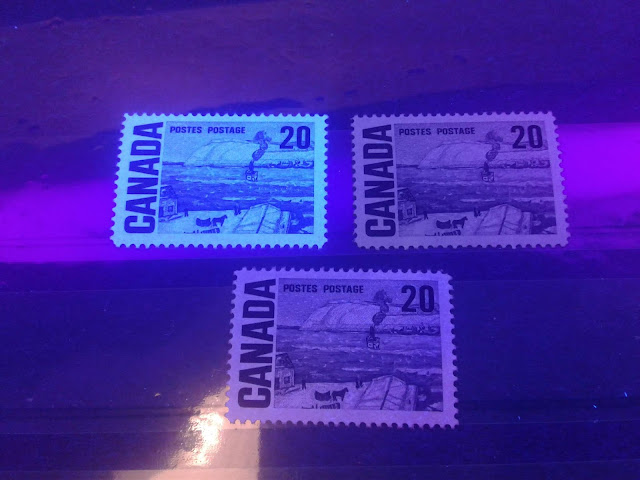
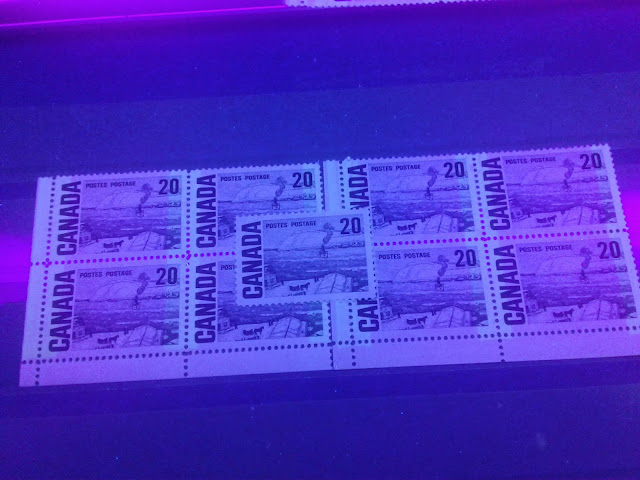
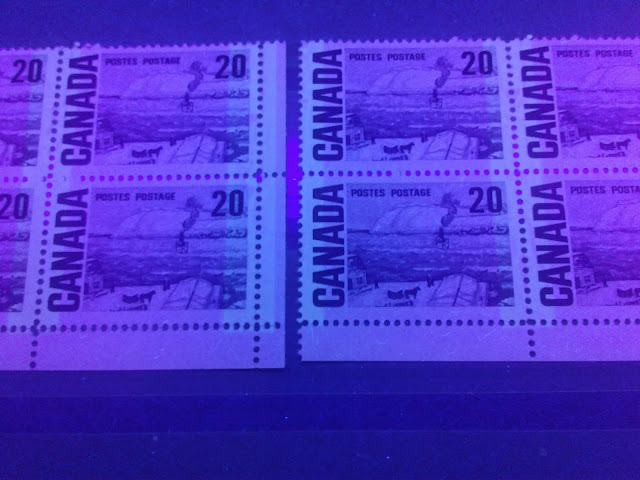
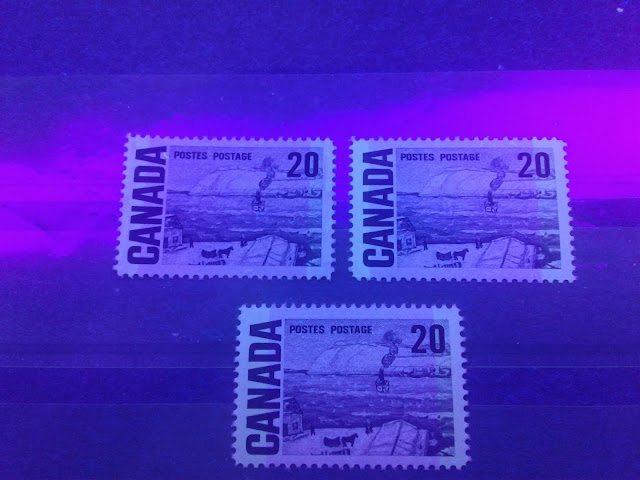
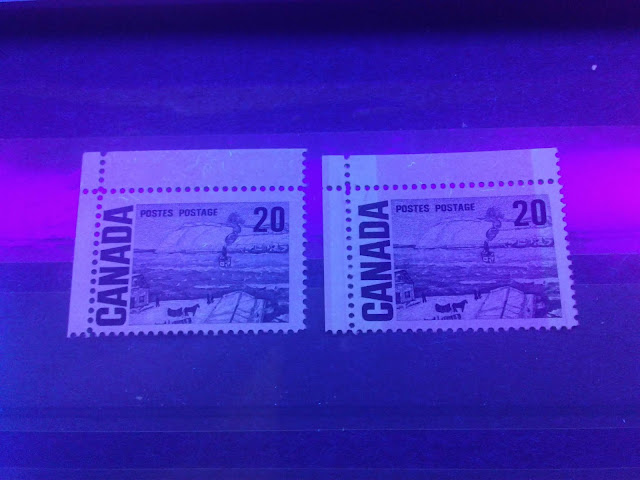
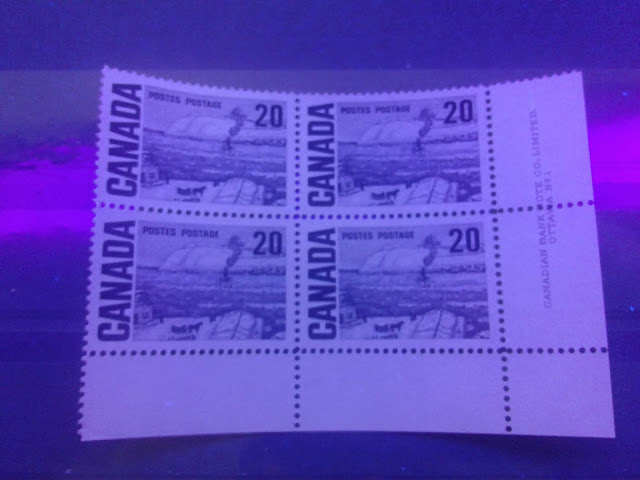
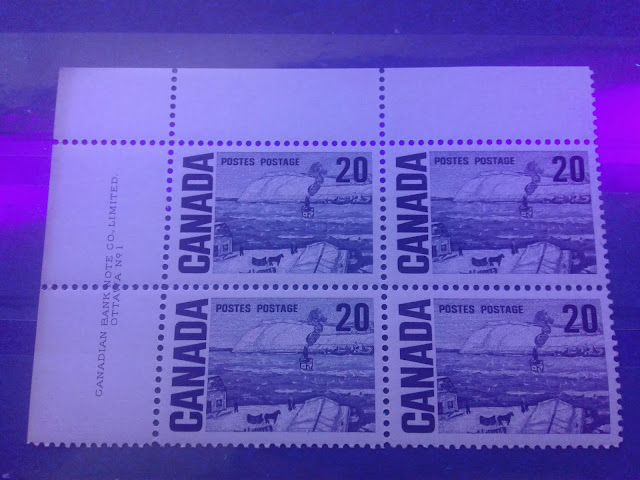
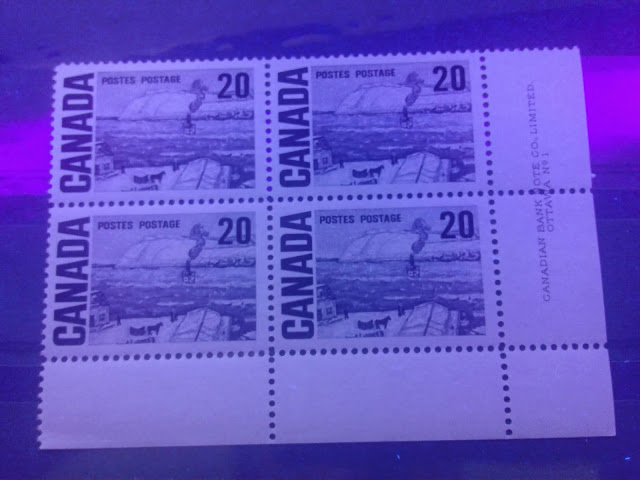
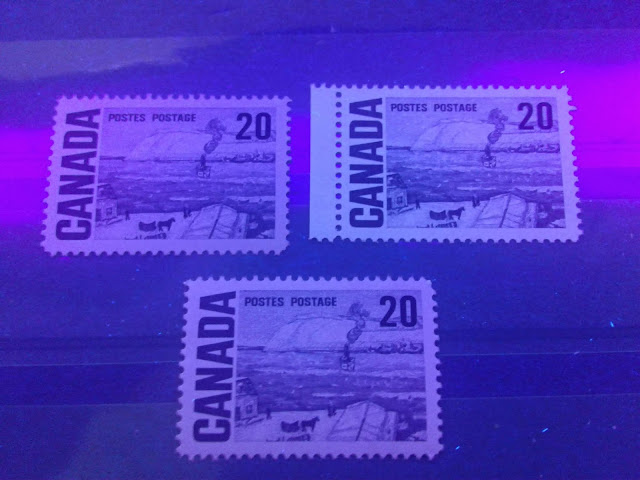

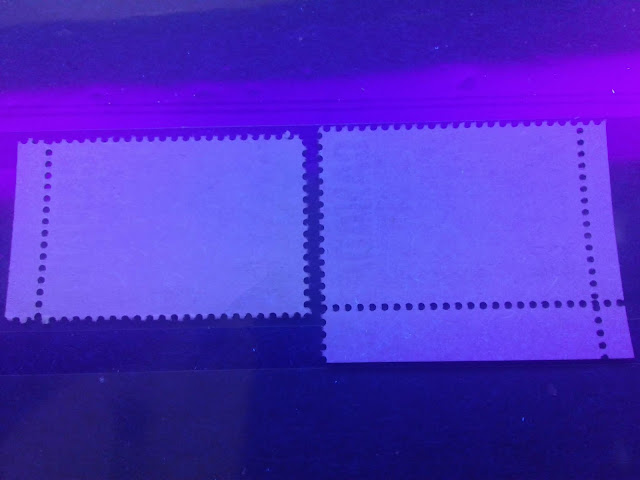

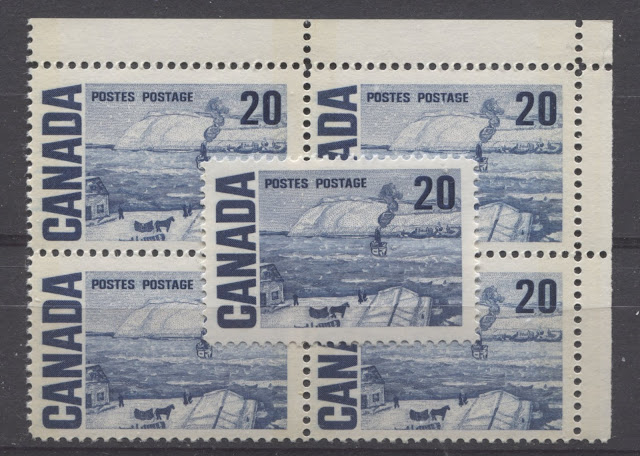
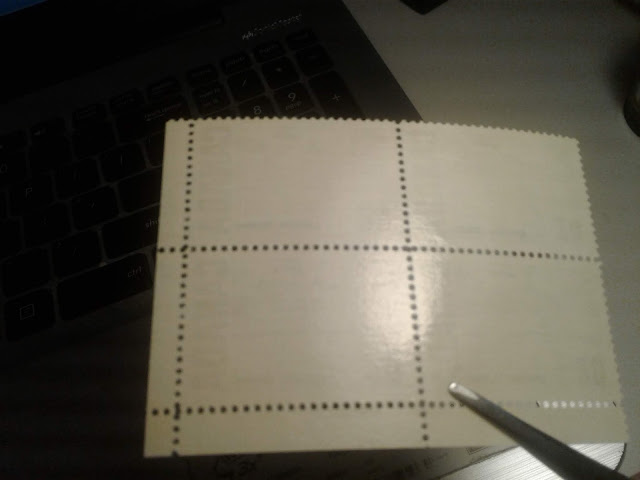
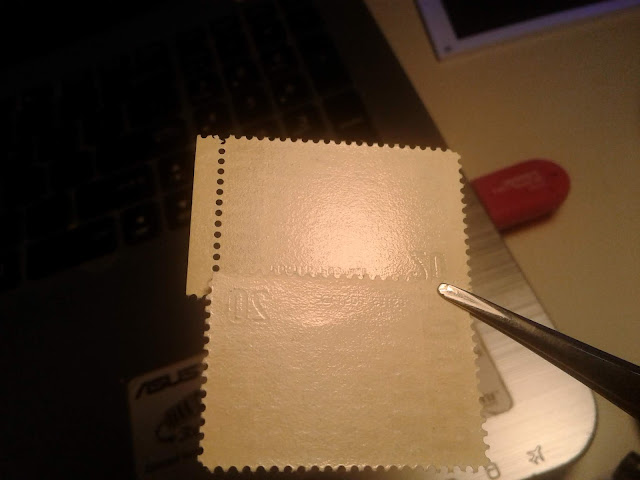


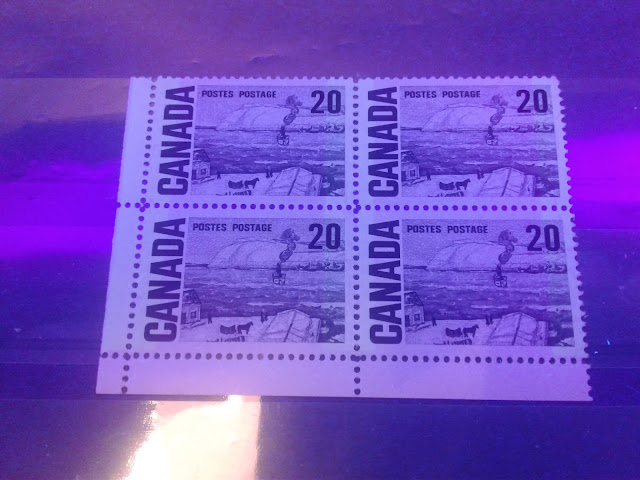
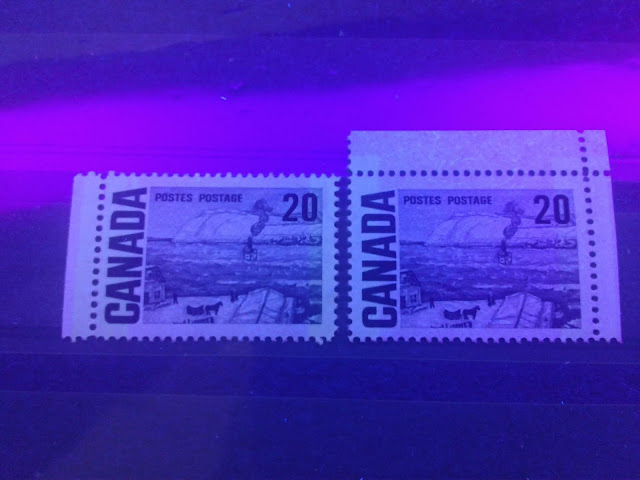
1 comment
I have a block of 18 used of these and I can’t see any tagging under UV light any where .
Are these valuable?
Thanks